- Crocus Flowers: A Complete Guide
- Introduction
- Types of Crocus Flowers
- Planting Crocuses
- Caring for Crocuses
- Propagation
- Pests and Diseases
- Conclusion
- Choosing the Right Crocus Varieties
- Color
- Size
- Blooming Time
- Other Considerations
- Planting Crocuses: Tips and Techniques
- Crocus Varieties
- Planting Time
- Planting Depth
- Watering and Care
- Maintenance
- Soil Requirements for Crocuses
- 1. Drainage:
- 2. pH Level:
- 3. Texture:
- 4. Nutrients:
- 5. Sunlight Exposure:
- Watering and Fertilizing Crocuses
- Watering
- Fertilizing
- Sunlight and Temperature Needs for Crocuses
- Sunlight Requirements
- Temperature Range
- Protecting Crocuses from Pests and Diseases
- Pests:
- Diseases:
- Conclusion:
- Dividing and Propagating Crocus Plants
- 1. Timing
- 2. Preparation
- 3. Digging up the bulbs
- 4. Separating the bulbs
- 5. Replanting the divisions
- 6. Watering and care
- 7. Propagating through seeds
- 8. Monitoring and maintenance
- Questions and Answers:
- How long do crocuses bloom for?
- When is the best time to plant crocus bulbs?
- What type of soil do crocuses prefer?
- Do crocuses need full sun?
- How often should crocuses be watered?
- Videos: The whole process of snapdragon planting
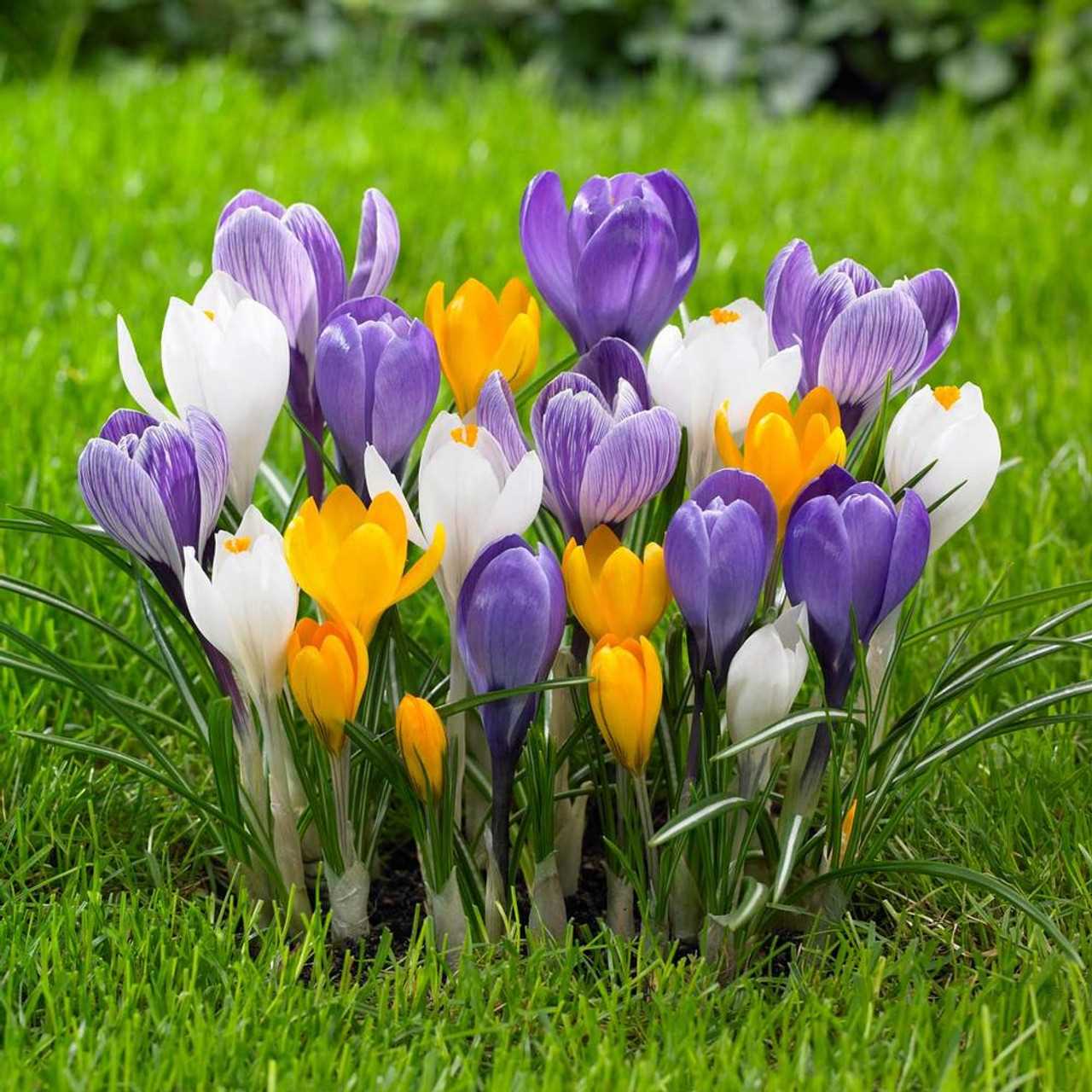
Crocus flowers are a delightful early spring bloom that brings vibrant colors and delicate beauty to any garden. These small, perennial plants are native to Europe, North Africa, and the Middle East and are a favorite amongst many garden enthusiasts. With a wide range of colors available, including purple, yellow, white, and striped varieties, crocuses are sure to add a splash of cheer to your garden.
Growing crocuses is relatively easy, making them an ideal choice for both experienced gardeners and beginners. They can be grown in containers, borders, or even naturalized in lawns. To achieve the best results, it’s important to plant crocus bulbs in the fall, typically in September or October, before the ground freezes. This allows the bulbs to establish themselves properly before the arrival of spring.
Once planted, crocuses require minimal care. They prefer well-draining soil and full sun to partial shade. During the growing season, it’s important to keep the soil moist but not overly saturated. However, it’s important to note that crocuses are very hardy and can tolerate periods of dryness.
In terms of maintenance, crocuses require little attention. Deadheading the flowers after they finish blooming can help redirect energy back to the bulb for next year’s growth. Additionally, it’s recommended to leave the foliage in place until it naturally withers and turns brown, as this helps the bulb store energy for future growth.
Tip: To ensure a longer blooming period, consider planting different varieties of crocuses. Early, mid-season, and late-blooming varieties will provide continuous color throughout the spring.
Crocus flowers are not only beautiful additions to any garden, but they also serve as an important food source for early pollinators such as bees and butterflies. Their pollen and nectar attract these beneficial insects, aiding in their survival and helping to promote a healthy ecosystem. So, by growing crocuses, you’re not only enhancing your garden’s beauty but also contributing to the well-being of your local wildlife.
With their stunning colors and easy care requirements, crocuses are a must-have for any flower lover’s garden. Whether you’re planting them in containers, beds, or lawns, these charming flowers will bring joy and anticipation to your garden each spring. Follow these tips for growing and caring for crocuses, and soon you’ll be rewarded with a breathtaking display of color and fragrance in your own backyard.
Crocus Flowers: A Complete Guide
Introduction
Crocus flowers are beautiful, early blooming plants that can add a pop of color to any garden. They are known for their vibrant petals and delicate yet hardy nature. In this complete guide, we will cover everything you need to know about growing and caring for crocuses.
Types of Crocus Flowers
There are over 80 different species of crocus flowers. They come in various colors, including shades of purple, white, yellow, and orange. Some popular types of crocuses include:
- Spring crocuses
- Winter crocuses
- Dutch crocuses
- Wild crocuses
Planting Crocuses
Crocus bulbs should be planted in the fall, around 4-6 weeks before the first frost. They prefer well-draining soil and a location that receives full sun or partial shade. To plant crocuses:
- Select a planting location
- Prepare the soil by removing any weeds or rocks
- Dig a hole that is 3-4 inches deep
- Place the crocus bulb in the hole, pointed end up
- Cover the bulb with soil and gently press down
- Water the area thoroughly
Caring for Crocuses
Caring for crocuses is relatively easy, as they are low-maintenance plants. Here are some tips for their care:
- Water regularly, especially during dry spells
- Apply a balanced fertilizer in early spring
- Remove any dead blooms or foliage to promote new growth
- Protect them from excessive moisture, as it can lead to bulb rot
- Leave the foliage intact after blooming, as it helps the bulb store energy for next year’s growth
Propagation
Crocuses can be propagated through division or by collecting and planting their seeds. Division can be done in early summer when the foliage has died back. To divide crocuses:
- Carefully dig up the clump of crocuses
- Separate the bulbs, ensuring each division has its own roots
- Replant the divided bulbs in a new location or give away to friends and family
Pests and Diseases
Crocuses are generally resistant to pests and diseases. However, they can occasionally be affected by aphids, slugs, or squirrels. To keep pests and diseases at bay, consider the following:
- Remove any dead leaves or plant debris from the area
- Apply organic insecticides or repellents, if necessary
- Use protective netting or fences to deter squirrels
Conclusion
Crocus flowers are a delightful addition to any garden. With their wide range of colors and early blooming nature, they bring joy and beauty to the spring landscape. By following the steps outlined in this complete guide, you can successfully grow and care for crocuses in your own garden.
Choosing the Right Crocus Varieties
When it comes to choosing the right crocus varieties for your garden, there are a few factors to consider. Crocuses come in a variety of colors, sizes, and blooming times, so you can create a stunning display throughout the year.
Color
One of the main reasons people choose crocuses is for their vibrant and diverse color range. From traditional purple and yellow varieties to more unique shades like white, orange, and even striped or two-toned blooms, there are countless options to suit your personal taste and garden design.
Size
Crocus plants vary in size, with some growing as short as 4 inches and others reaching up to 6 inches or more. Consider the height and spread of each variety when planning your flowerbeds to ensure a balanced and visually appealing arrangement.
Blooming Time
Another important factor to consider when choosing crocus varieties is their blooming time. Crocuses can be categorized into three main groups based on their blooming period: early, mid, and late bloomers.
- Early bloomers typically appear in late winter or early spring, often even before the last frost. These crocuses are a welcome sight after the cold winter months and can be a sign that warmer weather is on the way.
- Mid-bloomers usually come out in late spring, filling the garden with color as the weather gets warmer. They provide a transition between the early and late-blooming varieties.
- Late bloomers are the last to flower, usually appearing in late spring or early summer. They can extend the blooming period in your garden and provide a pop of color as other flowers start to fade.
Other Considerations
In addition to color, size, and blooming time, there are a few other factors to consider when choosing crocus varieties. Some crocuses are scented and can add a delightful fragrance to your garden. Additionally, certain varieties are more tolerant of shade or wet conditions, making them suitable for specific areas of your garden. It’s also worth considering if you want crocuses that naturalize, meaning they spread and come back year after year, or if you prefer to plant new bulbs each season.
| Variety | Color | Blooming Time | Scented | Tolerance | Naturalizing |
|---|---|---|---|---|---|
| Traditional Crocus | Purple, Yellow | Early | No | Tolerates Shade | Yes |
| Giant Crocus | Various | Early to Mid | No | Tolerates Wet Conditions | Yes |
| Striped Crocus | Striped | Early | No | Tolerates Sun | Yes |
| White Crocus | White | Early | Yes | Tolerates Shade | Yes |
By considering these factors and researching different crocus varieties, you can select the right ones for your garden and create a stunning display of color and texture throughout the year.
Planting Crocuses: Tips and Techniques
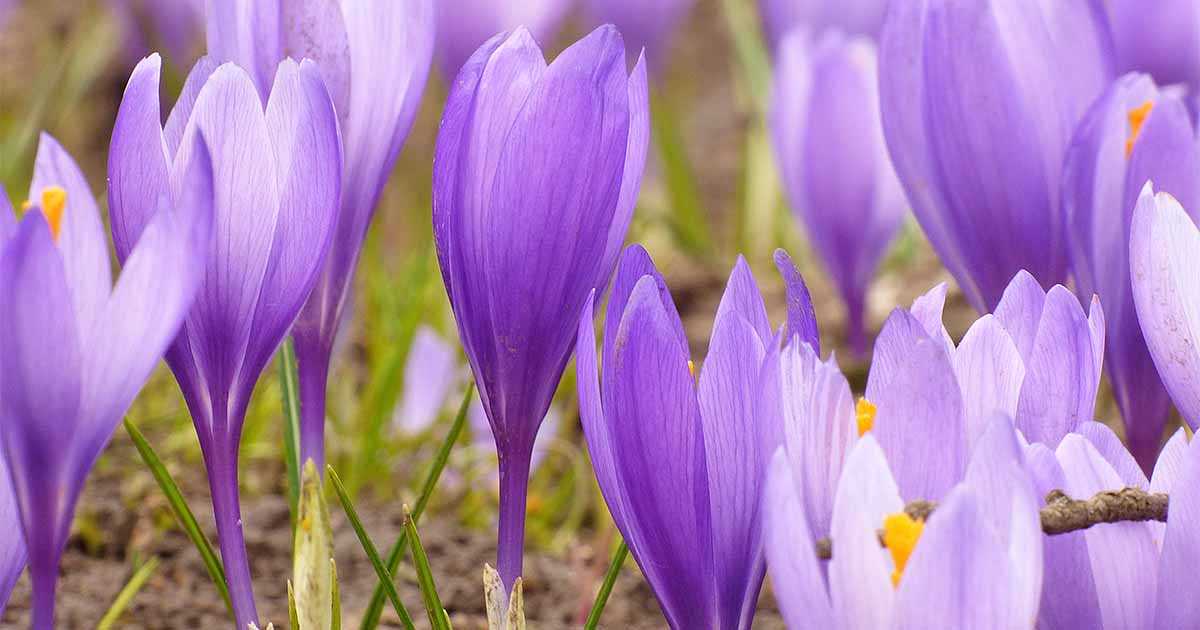

Planting crocuses is a simple and rewarding task that can be done by beginners and experienced gardeners alike. These early-blooming flowers bring a burst of color to the garden, signaling the arrival of spring. Here are some tips and techniques to help you successfully plant and care for crocuses:
Crocus Varieties
Before you start planting crocuses, it’s important to choose the right variety. There are various types of crocuses available, including spring-flowering crocuses and autumn-flowering crocuses. Spring-flowering crocuses are planted in the fall, while autumn-flowering crocuses are planted in the summer. Consider the blooming time and colors of the crocuses you choose to create a cohesive and visually appealing garden.
Planting Time
The best time to plant crocuses is in late summer or early autumn. This allows the bulbs to establish roots before the ground freezes. Planting in early spring is also an option, but the bulbs may not have enough time to establish themselves before the warmer weather arrives. Crocuses prefer well-drained soil, so make sure the planting area is suitable.
Planting Depth
Crocus bulbs should be planted at a depth of about 3-4 inches (7-10 cm). Dig a small hole or trench, and place the bulbs in an upright position with the pointed end facing upwards. Space the bulbs about 3-4 inches (7-10 cm) apart to allow room for growth. Cover the bulbs with soil and gently press down to secure them in place.
Watering and Care
After planting, water the crocus bulbs thoroughly to help settle the soil. Crocuses don’t require much water once they are established, but it’s important to keep the soil slightly moist during the growing season. Avoid over-watering, as this can cause the bulbs to rot. Apply a layer of mulch around the planted area to help retain moisture and suppress weeds.
Maintenance
Crocuses are relatively low-maintenance plants, but there are a few things you can do to ensure their continued growth and longevity. Remove any dead foliage or spent flowers to prevent disease and promote new growth. In the autumn, apply a balanced fertilizer to provide the bulbs with nutrients for the following season. As the bulbs multiply over time, you may need to divide and transplant them to prevent overcrowding.
By following these tips and techniques, you can enjoy a beautiful display of crocuses in your garden. Their vibrant colors and delicate flowers will bring joy and warmth to your outdoor space, signaling the arrival of spring.
Soil Requirements for Crocuses
The success of growing crocuses largely depends on the soil conditions they are planted in. Crocuses prefer well-draining soil with a pH level between 6.0 and 7.0. Here are some guidelines for providing the right soil conditions for your crocuses:
1. Drainage:
Crocuses do not tolerate wet or waterlogged soil. It is important to ensure that the soil has good drainage to prevent the bulbs from rotting. If your soil is heavy or clayey, you can improve drainage by adding organic matter such as compost or well-rotted manure.
2. pH Level:
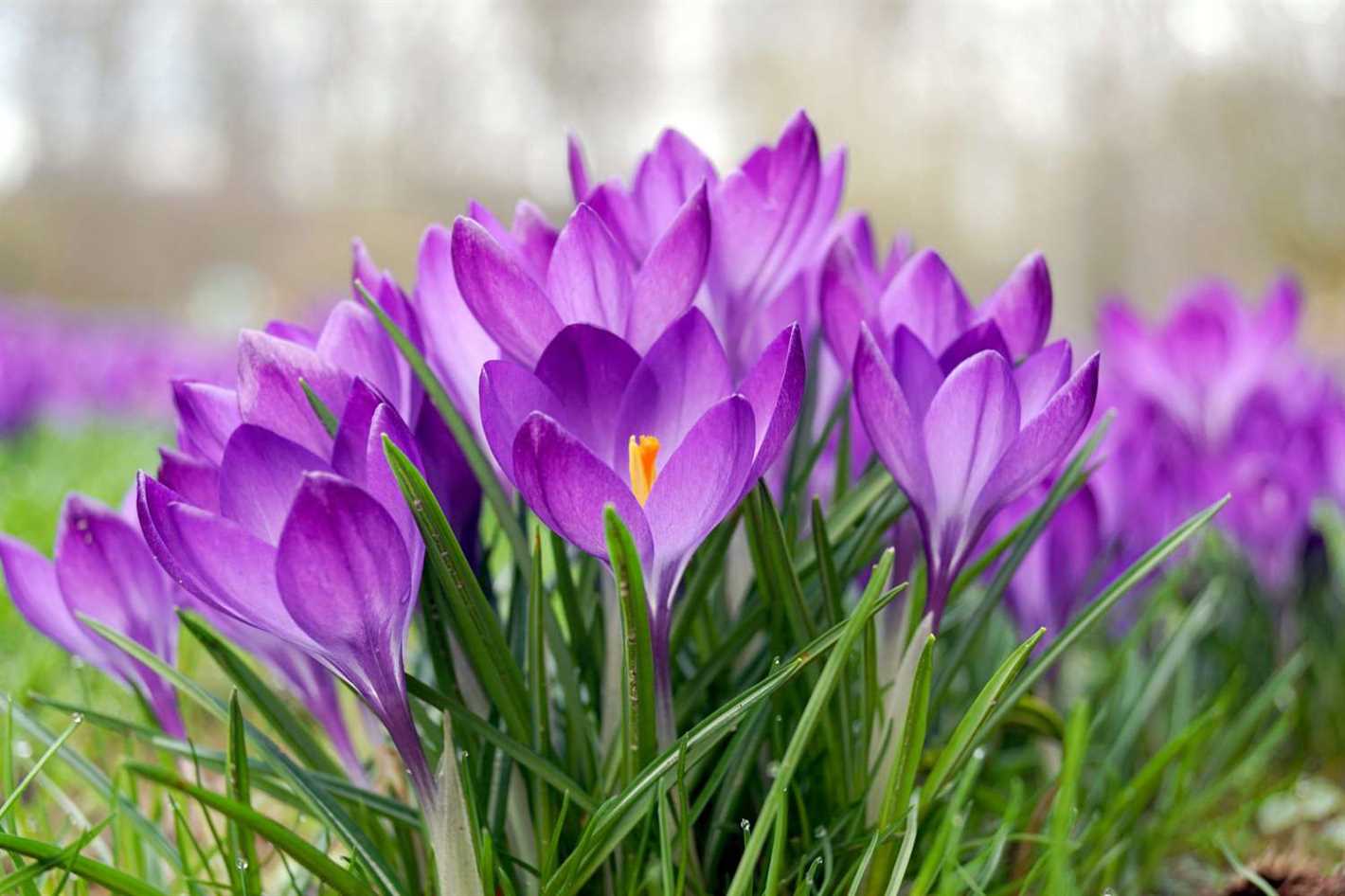

The ideal pH level for crocuses is slightly acidic to neutral. Test your soil’s pH level using a soil testing kit and adjust it accordingly. If the soil is too acidic, you can add lime to raise the pH. If the soil is too alkaline, you can add sulfur or peat moss to lower the pH.
3. Texture:
Crocuses prefer soil with a sandy or loamy texture. These soil types provide good drainage while also retaining enough moisture for the bulbs. If your soil is heavy or clayey, you can improve its texture by adding sand or loam.
4. Nutrients:
Crocuses require a well-balanced supply of nutrients to grow and bloom successfully. Before planting, it is recommended to add a slow-release fertilizer or organic matter such as compost or well-rotted manure to the soil. This will provide the necessary nutrients for the bulbs to develop and produce beautiful flowers.
5. Sunlight Exposure:
Crocuses thrive in full sunlight or partial shade. When choosing a location for planting, make sure it receives at least 6 hours of direct sunlight per day. The sunlight exposure will not only help the flowers to bloom, but it will also aid in drying out the soil and preventing excess moisture.
By providing the right soil conditions, you can ensure the healthy growth and vibrant blooms of your crocuses. Remember to regularly water and monitor the soil moisture to maintain optimal conditions for the bulbs.
Watering and Fertilizing Crocuses
Proper watering and fertilizing is essential for the healthy growth and blooming of crocuses. In this section, we will discuss the best practices for watering and fertilizing these beautiful flowers.
Watering
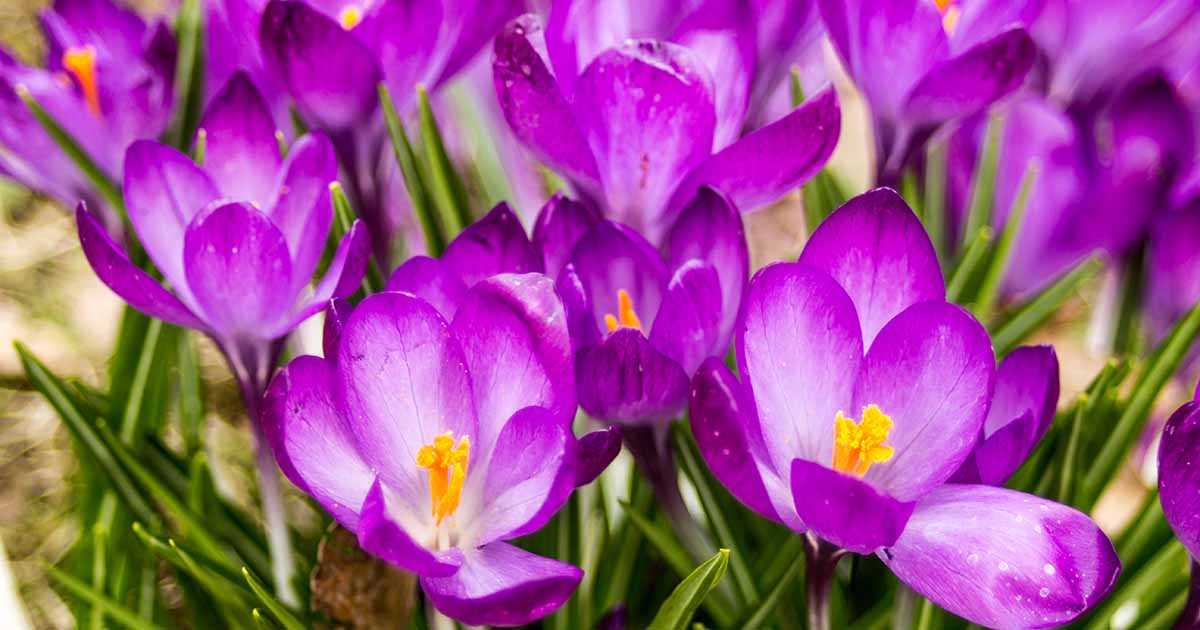

Crocuses require regular watering, especially during their blooming period. The frequency of watering will largely depend on the climate and the moisture retention capacity of the soil. Here are some guidelines for watering crocuses:
- Water the crocuses deeply once a week during dry spells.
- Avoid overwatering as it can cause bulb rot.
- Ensure that the soil is well-drained to prevent waterlogging.
- Water in the morning to allow the foliage to dry out during the day.
- During the dormant period, reduce the amount of water to prevent bulb decay.
Fertilizing
Appropriate fertilization can enhance the overall health and vigor of crocuses. Here are some tips for fertilizing crocuses:
- Apply a balanced slow-release fertilizer in early spring before the plants start to grow.
- Avoid using high-nitrogen fertilizers, as they can cause excessive foliage growth at the expense of flower production.
- Follow the instructions on the fertilizer packaging for the correct application rate.
- Avoid direct contact between the fertilizer and the crocus bulbs to prevent burning.
- Incorporate well-rotted compost or organic matter into the soil before planting to provide additional nutrients.
By following these watering and fertilizing guidelines, you can ensure that your crocuses thrive and produce beautiful blooms year after year.
Sunlight and Temperature Needs for Crocuses
Crocus flowers require a specific amount of sunlight and a certain temperature range in order to thrive. Understanding their light and temperature needs is crucial for successful crocus cultivation.
Sunlight Requirements
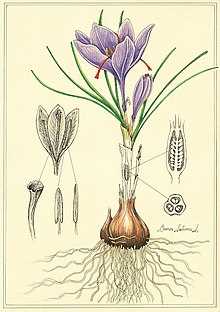

Crocuses are sun-loving flowers and require at least 6 hours of direct sunlight per day. They should be planted in locations that receive full sun or partial shade. Full sun exposure will result in more blooms and vibrant colors, while partial shade can help protect the flowers from intense heat.
Temperature Range
Crocuses are cold-hardy plants that can tolerate temperatures as low as -15°C (5°F). However, they also require a period of cold dormancy in order to flower. They are ideally suited for temperate climates with cold winters and mild springs. The optimal temperature range for crocuses is between 10°C (50°F) and 20°C (68°F).
During the winter, crocus bulbs require a chilling period of at least 12-16 weeks at temperatures below 10°C (50°F) to develop their flowers. This chilling period can be naturally provided by cold winter temperatures, or it can be artificially simulated by refrigerating the bulbs before planting.
It is important to note that crocuses may bloom earlier in warmer climates and later in colder climates. Spring-blooming crocuses will usually emerge when the soil temperature reaches around 10°C (50°F), while fall-blooming varieties will emerge when the soil temperature drops to about 13°C (55°F).
Protecting Crocuses from Pests and Diseases
Crocuses are generally low-maintenance plants, but like any other plant, they can be susceptible to various pests and diseases. Here are some common ones and how to protect your crocuses from them:
Pests:
- Aphids: These small insects feed on the sap of crocuses, causing them to weaken and wilt. To control aphids, regularly inspect your plants and remove any infested leaves or flowers. You can also spray them with a soap and water solution or use insecticidal soap.
- Slugs and Snails: These slimy pests can eat through the leaves and flowers of crocuses. To protect your plants, create barriers such as copper tape or use organic slug and snail bait. You can also handpick them and relocate them away from your crocuses.
- Squirrels: Squirrels sometimes dig up crocus bulbs searching for food. To deter them, you can sprinkle blood meal or bone meal around your crocus bed. You can also cover the area with mesh or wire to prevent them from accessing the bulbs.
Diseases:
- Botrytis Blight: This fungal disease can cause gray mold to form on the leaves and flowers of crocuses. To prevent botrytis blight, avoid over-watering your plants and ensure good air circulation. Remove and dispose of any infected plant material.
- Root Rot: Excessive moisture and poor drainage can lead to root rot in crocuses. To prevent this disease, make sure to plant your bulbs in well-draining soil and avoid over-watering. If you notice signs of root rot, such as wilting leaves and mushy bulbs, remove and discard the affected plants.
- Viruses: Crocuses can sometimes be infected by viral diseases, which can cause stunted growth and discolored leaves. To prevent virus transmission, avoid using infected bulbs and regularly sanitize your gardening tools. There is no cure for viral infections, so infected plants should be removed and destroyed.
Conclusion:
By being vigilant and taking preventive measures, you can protect your crocuses from pests and diseases. Regularly inspect your plants, provide proper care, and promptly address any issues that arise. With the right protection, your crocuses can thrive and brighten up your garden.
Dividing and Propagating Crocus Plants
Dividing and propagating crocus plants is a great way to increase your crocus collection or share them with others. Here are some steps you can follow to successfully divide and propagate your crocus plants:
1. Timing
The best time to divide and propagate crocus plants is during their dormant period, which is typically in late summer or early fall. This is when the foliage has died back and the plants are in a resting phase.
2. Preparation
Before dividing your crocus plants, make sure you have the necessary tools and materials. This includes a sharp, clean gardening knife or shovel, a container for the new divisions, and well-draining soil or potting mix.
3. Digging up the bulbs
To divide the crocus plants, carefully dig up the bulbs using the garden knife or shovel. Be gentle to avoid damaging the bulbs or their roots. Lift the bulbs out of the ground, and shake off any excess soil.
4. Separating the bulbs
Once the bulbs are out of the ground, carefully separate them into individual sections. Each section should have its own roots and a healthy bulb attached. Discard any bulbs that are damaged or diseased.
5. Replanting the divisions
Prepare the new location or containers for the divided crocus bulbs by ensuring the soil is well-draining and loose. Plant each division at a depth of 2-3 inches, with the pointed end facing up. Cover the bulbs with soil and gently firm it around them.
6. Watering and care
Water the newly divided crocus bulbs thoroughly after planting. After that, water regularly to keep the soil moist but not waterlogged. In colder climates, mulching the soil surface can help protect the bulbs during winter.
7. Propagating through seeds
If you prefer to propagate crocus plants through seeds, collect the seeds from the spent flowers in late spring or early summer. Sow the seeds in well-draining soil and keep them moist until they germinate. Transplant the seedlings when they are large enough to handle.
8. Monitoring and maintenance
Monitor the newly divided and propagated crocus plants for signs of growth and health. Remove any weeds or competing plants that may interfere with their growth. Fertilize the plants once or twice a year with a balanced fertilizer.
By following these steps, you can successfully divide and propagate your crocus plants, allowing you to enjoy more of these beautiful flowers in your garden or share them with others.
Questions and Answers:
How long do crocuses bloom for?
Crocuses typically bloom for about 2-3 weeks.
When is the best time to plant crocus bulbs?
The best time to plant crocus bulbs is in the fall, about 6-8 weeks before the ground freezes.
What type of soil do crocuses prefer?
Crocuses prefer well-draining soil that is rich in organic matter.
Do crocuses need full sun?
Yes, crocuses prefer full sun, but they can also tolerate partial shade.
How often should crocuses be watered?
Crocuses should be watered regularly during their active growing season, but they do not like to sit in soggy soil, so it is important not to overwater.







